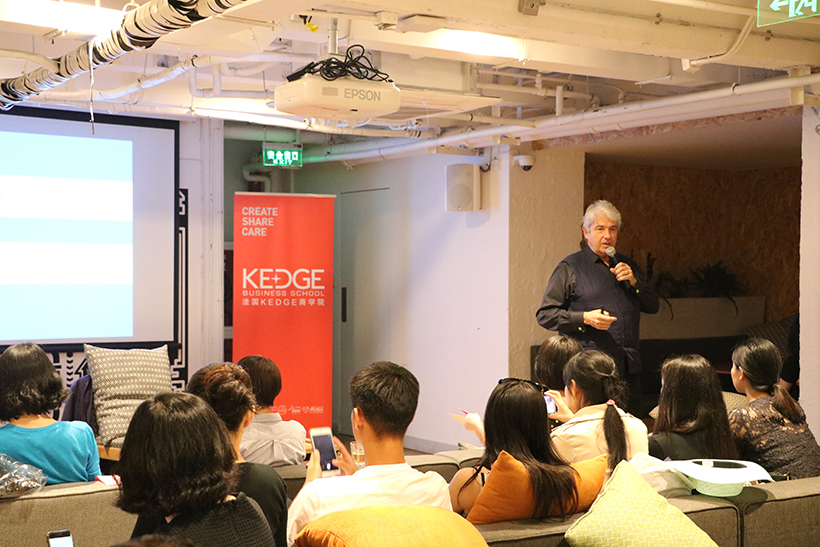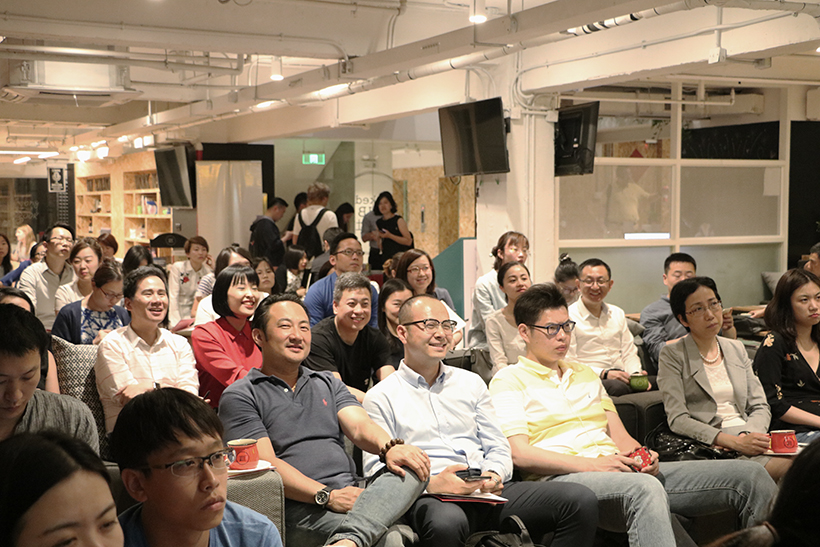May 31, 2017 - In an open class themed “Branding in the Age of Social Media”, Professor Michel Gutsatz of the KEDGE-SJTU Global MBA Program led an in-depth exploration of the changes and challenges for brand marketing in the age of social mediaby sharing compelling business cases from China and abroad.
Leveraging the power of social media
With the advent of social media, brands started to engage invarious social media and invest in advertisement through these media. Unfortunately, such investments turn out counterproductive in many cases. What then, are the reasons behind these disappointments?
Many brands would just blatantly feed raw information into their timelines on social media platforms such as Facebook, Twitter, Google+ and Instagram, leaving users overwhelmed by such incessant “harassment”. Most of these brands even fail to understand who are the consumers of their information, let alone their needs, or whether they belong to their target audience or not. Most of the time, advertisement spending on social media ispaidin vain.
To succeed in social media marketing, therefore, requires your brand to do away with the aloofness and distance, andengage instead in real dialogs withyour target consumers as you would do in daily conversations. It is also important to develop a digital ecosystem rather than just advertisingdigitally. The 21st century is the age of social media. It has moved on from the times when consumers watched whatever advertisers fed them. Chinese companies should make use of user-generated content?a key element of social media in China, to engage in equal dialog with their customers.
Advertising: the age of community culture and popular culture
Before 2000, advertisements were about the repetition of keywords and enumeration of product features. Right after the turn of the millennium, with the launch of eight short video adverts by BMW between 2001 and 2002, “storytelling” began to establish itself as a buzzword among advertising agents. Marketers started to shift their focus onto building relations between brands and their consumers, developing offline events, games and opinion-leadership communication.

However, in today’s world, how do blockbuster advertisements perform in attracting followers? To answer this question, Professor Gutsatz presented a chart showing the results of a survey, according to which, consumers trust their family and friends the most when it comes to referrals, while brand marketing is among one of the least trusted sources. Today, the good-old BMW-styled video ads have gone stale as they become ubiquitous and consumers no longer buy what “brand stories” try to advocate.
Under such circumstances, the first priority for brand marketers should be to keep track of social media users’ network of relationships based on their needs. You can then identify specific topics that are able to bind your users together, in a way so powerful that many of these topics develop into subcultures. According to Professor Gutsatz, the communication of these kinds of popular culture presents new opportunities for brand marketing.
They created new products, new hobbies, new aesthetic perspectives, and even new ideologies. One of the best examples is e-sports, or competitive video gaming. On YouTube, only three “Fortune 500” companies have their own channels, and all of them are from the entertainment industry?after all, no one really cares if there is a channel for Coca-Cola or McDonald’s. The most-subscribed channel on YouTube, in fact, is a video gaming channel run by Pewdiepie, which is subscribed by a whopping 38 million users.
E-sports in China attract 147 million core users and register a revenue of RMB 141 billion. As a result, Tencent, an important entry point for a myriad of online games in China, has established its foothold in the market as one of the world’s top ten online gaming company. E-sports have apparently become part of the lifestyles of youngsters. Just like what Innisfree, a cosmetics brand in Korea, does to share the culture of Jeju Island, communicating the subcultures favored by customers has become the only way to attract consumers in today’s social media world. Brand marketers should all ask themselves this question: what kind of popular culture do their social media fans like?
Consumption: from material to culture
The open class started with a comparison of the cases of two major brands in the cosmetics industry: Innisfree and Sephora.
Innisfree builds itself on the pure and scenic nature of Jeju Island, so much so that it features a recommended tour on its official website. On the other hand, Sephora is identified as a highly commercialized company, a typical marketing machine in the age of consumerism.
Hong Kong, once a most visited destination by international travelers, has lost its appeal to visitors who increasingly favorcities like Bangkok, Tokyo and Taipei. Why has Hong Kong lost its charm? Perhapsit can be attributed to Hong Kong’s limited offerings of things to doother than shopping. On the other hand, culture and entertainment experiences are commonplace in today’s hot tourist destinations. Korea, for example, is heavily driven by its export of pop culture in a “fans economy”. These phenomena reflect a clear shift among consumers from material consumption towards culture consumption.
Professor Gutsatz then explained the key aspects of cultural consumption using three famous business cases from China and abroad. Chipotle,a Mexican fast food chain in the US, presents a case for a successful transformation making use of the trends of cultural consumption. To illustrate this, Professor Gutsatz showed an impressive animated video advertisement highlighting the efforts to provide more healthy and fresher food to customers, which is in line with the rising popularity of healthy diet and lifestyle in the US. The second case was about the famous toiletries brand “Dove”. A marketing campaign by Dove was introducedto celebrate the beauty of women, the main target of its products. The campaign video tells a story of a sketch artist that draws two sketches of the same person, oneaccording to their own description of themselves, and the other as described by a stranger that have seen them before. It turned out that most of the time, the sketches drawn from strangers’ description were more beautiful and resembled the person better. Women are likely to lack confidence in themselves because they tend to see their imperfectness and shortcomings more than they do other features. Therefore, when describing themselves, they would overemphasize these less attractive features. Inspired by this idea, Dove created the campaign to underscore the beauty of women. Without trying to feature its products, what Dove did was to deliver its brand culture and value to the consumers.
The last case is about Durex, which hasbeen marketing successfully in China. Before setting foot on the Chinese market, Durex had conducted a thorough research about their target consumers?young urban dwellers between 25 and 35 years old. Durex believes these people are posh, open, modern, dependent on social media, and they see dating as a game and find adventure a part of their lives. With this in mind, Durex decided to make a presence in social media, taking the topic of “sexual relationship” as its focus. On the Chinese microblogging platform Weibo.com, Durex created 139 updates within two weeks, half ofwhichwere just-for-fun contents about “sexual relationship” and clearly unrelated to the brand itself. Later, Durex created its own mobile game application “Durex Baby”. As its name suggests, the game is about caring a baby resulting from a passionate night with your partner. You must feed the baby, play with it, sing it lullabies, change its diapers, and you must bear with unexpected cries when you are in a meeting, using the bathroom, or even fast asleep at night. Finally, understanding that privacy comes hand-in-hand with the sexual relationship subculture, Durex has launched its WeChat store, so customers can directly order their products online without the need to feel embarrassed at store counters. Durex has created a unique social media concept by addressing customers’ concerns building on a specific subculture, which serves as a great example for marketing in Greater China.
A briefing of the KEDGE-SJTU Global MBA program
1 Top MBA program, No.22 in Financial Times Executive MBA 2016
2 Esteemed Schools with over a century’s heritage. SJTU founded in 1896, and KEDGE Business School founded in 1872.
3 International accreditations. China’s first MBA/EMBA achieved 3 international accreditations from both institutions.
About Michel Gutsazt

Associate Dean of KEDGE Business School
Director of MBA and EMBA programs, KEDGE Business School
Professor Gutsatz, currently adjunct professor at China Europe International Business School. Michel is one of the world leading experts on Brand Management. He was the founder of the MBA in International Luxury Brand Management at ESSEC.










